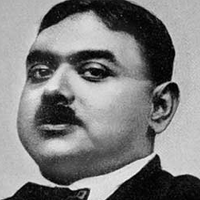R. D. Banerji
Rakhaldas Bandyopadhyay, also known as R D Banerji, was an Indian archaeologist and museum expert. He was the Manindra Chandra Nandy Professor of Ancient Indian History and Culture at the Banaras Hindu University from 1928–30. He is best known as the discoverer of Mohenjo-daro, the principal site of the Indus Valley Civilisation.
Bandyopadhyay was born in Berhampore of Murshidabad District in West Bengal to Matilal and Kalimati. He passed his F.A. examination in 1903 and graduated from Presidency College, Kolkata with Honours in History in 1907. He obtained his M.A. in History from the Calcutta University in 1911. Bandyopadhyay joined the Indian Museum in Calcutta in Archaeological Section in 1910. He joined the Archaeological Survey of India as Assistant Superintendent in 1911, and was promoted to the rank of Superintending Archaeologist of the Western Circle in 1917. In 1924, he was transferred to the Eastern Circle and took part in the excavations at Paharpur. He took voluntary retirement in 1926 to teach at the University of Calcutta, and he later joined the Banaras Hindu University in 1928 and held the post till his premature death on 23 May 1930.
Bandyopadhyay’s first major independent professional work was in the fields of palaeography and epigraphy. He won the Jubilee Research Prize of the Calcutta University for The Origin of the Bengali Script published in 1919. He was the first to study the proto-Bangla script, the original form of Bangla script. He researched in particular Gupta sculpture and architecture. His best known work was Eastern Indian Medieval School of Sculpture. Bandyopadhyay is popular for unearthing pre-Buddhist artifacts at the ruins at Mohenjo-Daro; for noting similarities between the site at Mohenjo-Daro and Harrappa. Those discoveries lead to excavations at the two sites that established the existence of the then-unknown Bronze Age Indus Valley Civilisation. He published in a number of books: “An Indian City Five Thousand Years Ago” ; “Mohenjo-Daro” ; Prehistoric, Ancient and Hindu India, History of India (1924), The Age of the Imperial Guptas (1933. History of Orissa from the Earliest Times to the British Period (1930 and 1931) .Prachin Mudra (1915), The Palas of Bengal (1915), The Temple of Siva at Bhumara (1924), The Paleography of Hati Gumpha and Nanaghat Inscriptions (1924), Bas Reliefs of Badami (1928) and The Haihayas of Tripuri and their Monuments (1931), Mayukh (1916) describes the Portuguese atrocities in Bengal during the reign of Shahjahan. Asim (1924) narrates the condition of Bengal during the reign of Farrukhsiyar. His last novel, Lutf-Ulla is set in Delhi at the time of the invasion by Nadir Shah.

R. D. Banerji
Date of Birth: 12 Apr 1885
Birth Place: Berhampore
Proffession: Indian archaeologist
Nationality: Indian
Death: 23 May 1930, Kolkata


